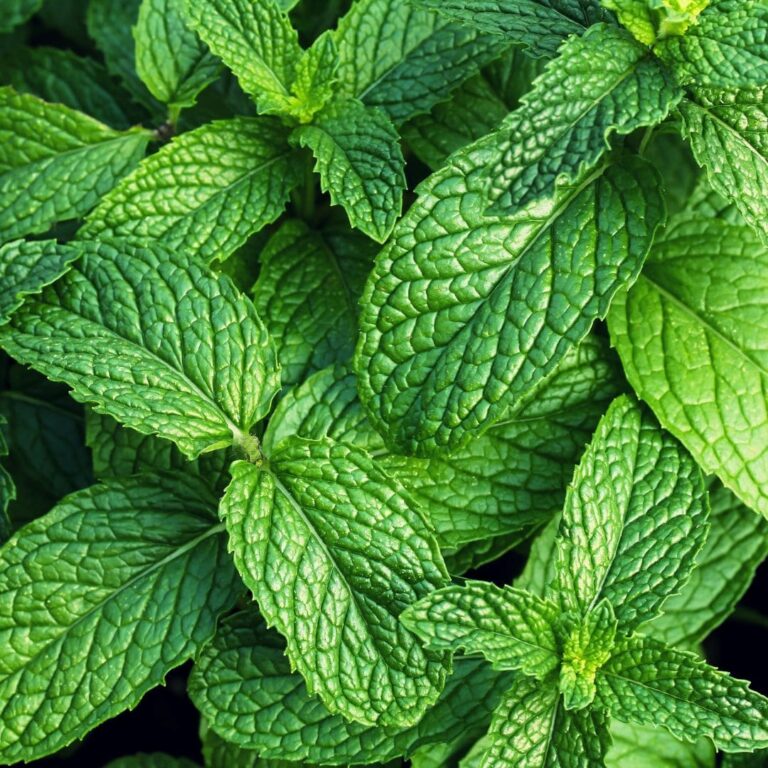Used since 300 BC by Mediterranean peoples, mint is an iconic plant in traditional medicine. It has always been present in Europe, growing naturally like many other aromatic herbs (rosemary, thyme, sage, etc.). Its inclusion in beverages came later, particularly with the famous “mint tea.”
The word “mint” comes from the Greek “Mínthê,” referring to Minthé, a nymph in Greek mythology. Legend has it that Demeter, Zeus’ wife, turned Minthé into mint because her beauty rivaled that of her daughter, Persephone.
Mint in Perfumes
Mints belong to the Lamiaceae family and constitute the Mentha genus. It is a perennial aromatic plant with green, serrated leaves. Its flowers resemble small spikes, ranging from white to purplish in color.
There are nearly 3000 species of mint, but the main ones used in perfumery are: peppermint (Mentha piperita), field mint (Mentha arvensis), spearmint or green mint (Mentha spicata), and lemon mint (Mentha citrata).
Mint thrives in the Mediterranean climate and grows easily in Europe. However, the world’s largest producer of green and peppermint mint is Morocco, while the United States and India are the primary producers of field mint.
The Raw Material from Mint
The parts of the plant used to obtain mint essential oil are the flowering tops. These are the ends of the stems, consisting of fairly young leaves and flowers. The hand-harvesting of the flowering tops takes place at the end of the flowering period, between July and August, depending on the species. The leaves contain the odor molecules. They are then steam-distilled to obtain mint essential oil.
The essential oils of different mint species are classified into several categories based on their predominant components: spearmint (green mint) belongs to “carvone mints,” peppermint and field mint are “menthol mints,” and lemon mint is a “linalool mint.” There are also “pulegone mints.”
Mint from the Perfumer’s Perspective
Mint belongs to the olfactory family of Aromatics. Its scent primarily appears as a top note in perfumes, providing freshness and naturalness.
At HF Perfumes, we use several species of mint: essential oils from green mints (Mentha Nanah and Mentha Spearmint), peppermint essential oil (Mentha Piperita), and lemon mint essential oil (Mentha Citrata).
The two green mints are quite different, both being variations of Mentha Spicata, known as Green Mint or Spearmint. Spearmint essential oil is fresh, herbaceous, and vegetal, with aromatic notes of wormwood. It is reminiscent of chlorophyll chewing gum. The “Nanah” mint is also a green mint (carvone type) from Morocco. Its essential oil has a fresh, herbaceous, almost liquor-like scent with aromatic notes of lavender and sage—it’s like a true Moroccan mint tea.
Peppermint is a hybrid between green mint and water mint (not used in perfumery). It’s a menthol mint. Its icy freshness dominates more subtle notes of resin with a mineral hint. Due to its potency, it is used sparingly in perfumes to prevent it from overpowering other elements.
Finally, Mentha Citrata contains a large amount of linalool. Its essential oil features notes of lemongrass and verbena, with top hints of lavender and mint. It then transitions into a duality of floral and citrusy notes of orange and bergamot.
The different species of mint allow for a broader range of minty notes, each bringing its own unique facets.
Some perfumes around the Mint note
- Polo – Ralph Lauren – 1978
- CK Be – Calvin Klein – 1996
- Aqua Allegoria Herba Fresca – Guerlain – 1999
- Eau d’Orange Verte – Hermès – 2009
- Batucada – L’Artisan Parfumeur – 2011
- Menthe Fraîche – Durance – 2012
- Verbena Mint – L’Occitane – 2013
- Malamata – Roos & Roos – 2022

Did you like this article?
Share it on:

